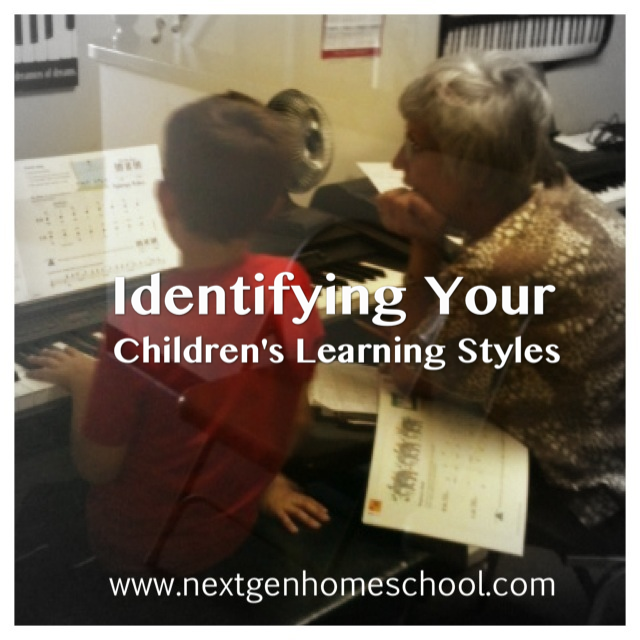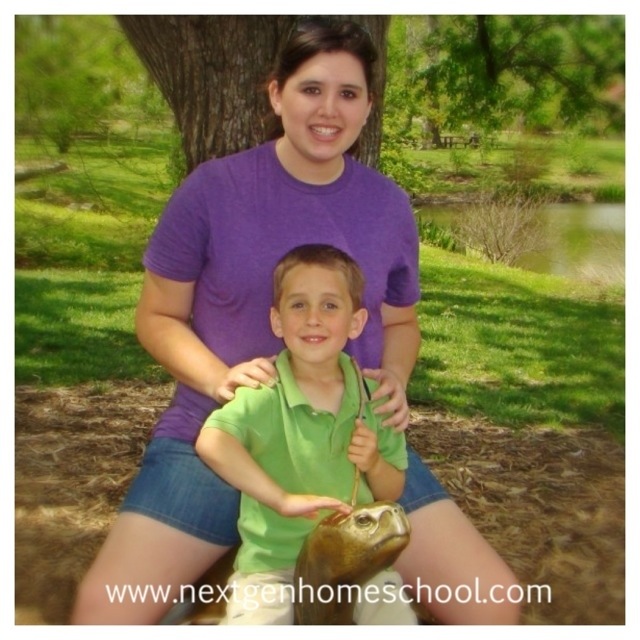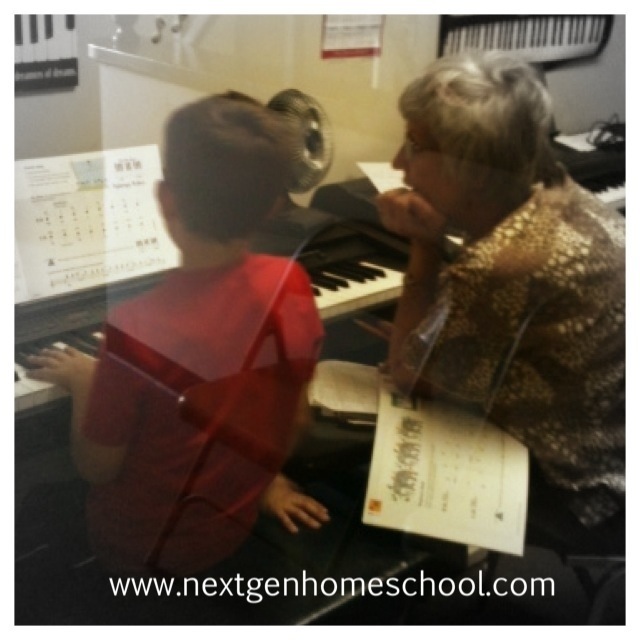When I first started homeschooling eight years ago, I didn’t really know much about learning styles. I also didn’t consider the differences in my girls learning styles when choosing our first curriculum. However, I soon discovered that the way I learn was not the way my daughters learn.
I am a very visual learner (or “read/write” learner as some tests call it), so the type of curriculum we used when I was homeschooled (workbooks and lots of reading and writing) worked well for me. However I now know that my eldest daughter is a kinesthetic learner. She needs to do something to really learn and remember it. If I had known this earlier, I might have chosen Math-U-See — a manipulative-based math curriculum — for her math program. My sister-in-law Renée recently wrote about why Math-U-See works for her girls. I did change to a unit study approach, which we all really enjoyed and allowed us to be more hands-on.
Then there was the mistake of lumping both of my daughters together. They are only 22 months apart but have different learning styles. My younger daughter Virginia is an auditory learner, which is really different from me. I remember that she always wanted me to be around and “explain” things to her, which frustrated me because I would say, “It’s right there in your book.” If I had understood that she was an auditory learner, I would have taken more time to read and discuss the directions with her. She also liked to do her schoolwork with music playing in the background, which really bothered me. Now that I know my 7-year-old son Joel is also an auditory learner, I am starting to figure out how to work with him differently.
My auditory learners: Virginia and Joel
If you are new to the concept of learning styles, you’re probably wondering: “How do I know what kind of learner my student is?”
Learning styles
The most basic learning styles are described as:
- Auditory – A preference for voice, sound and music in learning.
- Visual – A preference for pictures, diagrams, and written directions in learning.
- Kinesthetic – A preference to using his/her body, hands, and sense of touch for learning.
There are some more in-depth evaluations and breakdowns of learning styles and many books written on the subject. However, I think just having a foundational understanding of what the basic learning styles are and what to look for can help you work with your children more effectively right away:
For example, if your child is missing his shoes:
- A visual learner will remember where he/she saw them last and probably be able to find them. I can remember where I saw a red toy car (under the couch) two weeks ago.
- A kinesthetic learner will remember the last place he/she had them, but is lost if the shoes were moved.
- An auditory learner needs to be told exactly where to look for them.
When giving directions:
- A visual learner needs to see it written down to understand and remember it.
- An auditory learner will understand and remember oral directions.
- A kinesthetic learner needs to do the activity to understand and remember it.
Both Mardel’s Homeschool Web site online Learning Style Quiz and Cindy Down’s printable assessment are quickly accessible, easy to take, and simple starting points for identifying the learning styles of your children. This learning styles checklist from the HSLDA Web site is also a helpful quick tutorial on the subject.
Choosing curriculum
Once you know what learning style is most dominant in your student, choosing the right type of curriculum will make teaching them much easier. Mardel’s Homeschool Web site breaks down curriculum by learning styles, however it lists only the few options that they actually sell. In general, visual (or “read/write”) learners will do well with literary or workbook-based curriculum. The visual learner will also enjoy colorful illustrated texts. Auditory learners like audio (and video) components to the curriculum. Kinesthetic learners do best with manipulatives, activities, and projects to help them understand and cement the learning.
For example, I recently shared about how my auditory son loves the Story of the World Ancient Times Audiobook CD we use for history, as well as The Story of the World Activity Book, in this “What’s Working” post. I read directions out loud to him, and he reads his flashcards out loud over and over, as well as his spelling words. He is very good at phonics but has a hard time spelling because so many words aren’t spelled the way they sound. He also takes piano lessons.
Your visual learners will usually be great spellers because they remember seeing the words on the page. I remember as a child being a voracious reader, reading way above my grade level and being an excellent speller. However I couldn’t pronounce half the words I had read, whereas an auditory learner would have been able to pronounce the word but may not have been able to spell it correctly. For the kinesthetic learner, memorizing is tough. This is where jumping on the trampoline or jumping rope while reciting facts helps: Actually any kind of movement helps.
The next step
There is a flipside to this concern with teaching according to learning style: At some point, your children are going to have to learn things without the benefit of a teacher that puts it in a format they can digest. I think that as your child gets older and you have taught him/her about learning styles and how they learn, that they should practice learning with other styles.
For example, it’s a good idea for your visual learner to learn to take dictation: They might need that skill in college. Kinesthetic learners especially need to learn to adapt, as most college classes aren’t geared for their kind of learning. I remember that when I was in college, some students would record the lectures to listen to again later, and others (like myself) would take notes that we could read later.
My eldest daughter, a kinesthetic learner, started out her college career wanting to be a chef (hands on), but now her interest has moved to nutrition. She enjoys putting knowledge into action right away — that helps her understand and remember it. Subjects that do not have an immediate application don’t really interest her. She has developed the study skills she needs to get the information she needs to do well in all of her classes, but she enjoys the classes with immediate application.
 Hannah used to train at the Savory Chef and share her new skills with us at home.
Hannah used to train at the Savory Chef and share her new skills with us at home.
As a teacher, it’s important to know your learning style too, because it makes a difference in how you work best with your children. As a visual learner, I know that if someone tells me to do something or if I set a date to do something, I need to write it down and see it on paper if I am going to have any chance of remembering it. When my children walk up and ask me to help with a math question, then proceed to read it out loud to me, I am totally lost until I can read it on the page.
So when your students are frustrating you with what you perceive as their lack of understanding, most likely they just need you to give it to them in another format. Understanding learning styles will alleviate this struggle and help you work with your children more effectively.
Is the concept of learning styles new to you? Or are you already working with your children according to their learning styles? If so, how do you manage a family with several different learning styles working together? How has learning styles affected your curriculum choices? We’d love to know what impact the understanding of learning styles has had in your homeschool: Let us know in the comments below!
*This post may contain affiliate links. Please see our full disclosure policy for more information.




Great Article. We own a Private Tuition Centre in the UK and have loads of homeschool children get additional top ups in higher level Maths and Science. We use the KTS-II Learning styles report to help students understand their learing styles. Works great for both students and parents/Teachers. However, works best for learners 12yrs and older. They also do careeer reports for students. We use https://facebook.com/EssexCareerGuidance as our partner.
Great explanation! I’m visual-kinesthetic, my daughter is visual, and my son is kinesthetic, so the three of us work together pretty well. 🙂
That’s great, Amy! Thanks for commenting!
Love the way you helped break this down and give such great resources. Thank you for linking up with Ultimate Resources for Moms!
Thanks for reading and commenting. It is great to link up and learn from other mothers on this homeschool journey with us.